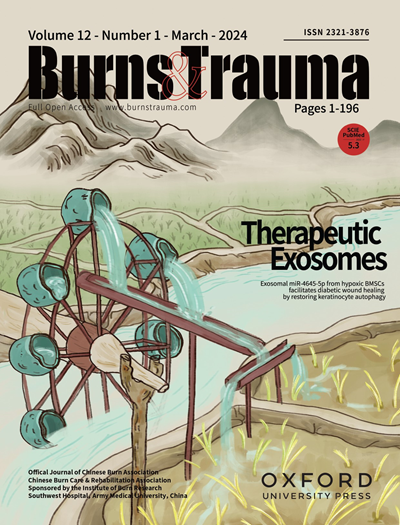在一种新型小鼠模型中,缝线锚定皮肤张力诱发持续性肥厚性瘢痕
IF 6.3
1区 医学
Q1 DERMATOLOGY
引用次数: 0
摘要
背景增生性疤痕导致皮肤外观和功能受损,严重影响身心健康。由于医学伦理和临床可及性等原因,人类疤痕标本的采集往往受到限制,建立疤痕实验动物模型用于科学研究迫在眉睫。目前最常用的四种增生性疤痕动物模型存在以下缺点:兔耳模型制作时间长;免疫缺陷小鼠增生性疤痕模型需要精心饲养和实验操作;雌性杜洛克猪购买和饲养成本高,且体型较大,难以制作大量模型;依靠拉力的小鼠疤痕模型需要特殊的皮肤拉伸装置,而这种装置经常损坏和脱落,导致模型建立不稳定。我们的研究小组克服了以往疤痕动物模型的缺点,创建了一种通过缝合固定伤口边缘诱导增生性疤痕的新型小鼠模型。方法 我们利用缝合锚定切口伤口,在整个愈合过程中施加定向张力,抑制伤口收缩,生成肉芽组织,从而诱导疤痕形成。小鼠背侧切口成对,上背部伤口边缘与肋骨缝合,下背部伤口边缘放松作为对照。为验证该方法的可靠性,还进行了宏观表现、显微组织学分析、mRNA 测序、生物信息学和体外细胞实验。结果 与松弛对照组相比,拉伸伤口的纤维化变化更为深刻。从组织学角度看,拉伸的疤痕细胞增生、血管增生、增殖旺盛,细胞外基质沉积紊乱,显示出肥厚性纤维化的分子特征。此外,拉伸疤痕与机械拉伸疤痕、人类肥厚性瘢痕和瘢痕疙瘩在转录上有重叠。磷脂酰肌醇 3- 激酶-丝氨酸/苏氨酸蛋白激酶 B 信号转导被认为是缝合线诱导的张力下抵抗细胞凋亡的促组织坏死介质。结论 这种直接的小鼠模型通过局部缝合张力抑制伤口收缩,成功诱导了病理肥厚性瘢痕的主要分子和组织学特征。该模型使我们能够探究张力诱导纤维化的机制并评估抗瘢痕疗法。本文章由计算机程序翻译,如有差异,请以英文原文为准。
Suture-anchored cutaneous tension induces persistent hypertrophic scarring in a novel murine model
Background Hypertrophic scars cause impaired skin appearance and function, seriously affecting physical and mental health. Due to medical ethics and clinical accessibility, the collection of human scar specimens is frequently restricted, and the establishment of scar experimental animal models for scientific research is urgently needed. The four most commonly used animal models of hypertrophic scars have the following drawbacks: the rabbit ear model takes a long time to construct; the immunodeficient mouse hypertrophic scar model necessitates careful feeding and experimental operations; female Duroc pigs are expensive to purchase and maintain, and their large size makes it difficult to produce a significant number of models; and mouse scar models that rely on tension require special skin stretch devices, which are often damaged and shed, resulting in unstable model establishment. Our group overcame the shortcomings of previous scar animal models and created a new mouse model of hypertrophic scarring induced by suture anchoring at the wound edge. Methods We utilized suture anchoring of incisional wounds to impose directional tension throughout the healing process, restrain wound contraction, and generate granulation tissue, thus inducing scar formation. Dorsal paired incisions were generated in mice, with wound edges on the upper back sutured to the rib cage and the wound edges on the lower back relaxed as a control. Macroscopic manifestation, microscopic histological analysis, mRNA sequencing, bioinformatics, and in vitro cell assays were also conducted to verify the reliability of this method. Results Compared with those in relaxed controls, the fibrotic changes in stretched wounds were more profound. Histologically, the stretched scars were hypercellular, hypervascular, and hyperproliferative with disorganized extracellular matrix deposition, and displayed molecular hallmarks of hypertrophic fibrosis. In addition, the stretched scars exhibited transcriptional overlap with mechanically stretched scars, and human hypertrophic and keloid scars. Phosphatidylinositol 3-kinase-serine/threonine-protein kinase B signaling was implicated as a profibrotic mediator of apoptosis resistance under suture-induced tension. Conclusions This straightforward murine model successfully induces cardinal molecular and histological features of pathological hypertrophic scarring through localized suture tension to inhibit wound contraction. The model enables us to interrogate the mechanisms of tension-induced fibrosis and evaluate anti-scarring therapies.
求助全文
通过发布文献求助,成功后即可免费获取论文全文。
去求助
来源期刊

Burns & Trauma
医学-皮肤病学
CiteScore
8.40
自引率
9.40%
发文量
186
审稿时长
6 weeks
期刊介绍:
The first open access journal in the field of burns and trauma injury in the Asia-Pacific region, Burns & Trauma publishes the latest developments in basic, clinical and translational research in the field. With a special focus on prevention, clinical treatment and basic research, the journal welcomes submissions in various aspects of biomaterials, tissue engineering, stem cells, critical care, immunobiology, skin transplantation, and the prevention and regeneration of burns and trauma injuries. With an expert Editorial Board and a team of dedicated scientific editors, the journal enjoys a large readership and is supported by Southwest Hospital, which covers authors'' article processing charges.
 求助内容:
求助内容: 应助结果提醒方式:
应助结果提醒方式:


